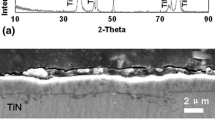Abstract
The mechanism of generating wear track grooves on metallic materials was investigated to elucidate the cause of similar wear track appearance based on pin-on-disk wear test results. As previously shown, most wear tracks on metallic materials appear similar in appearance irrespective of test conditions and materials. This phenomenon is attributed to the similar scales of prominent grooves in wear tracks, as wear tracks have common characteristic groove sizes in terms of width and depth. The ploughing by transfer particles adhering to counter surface initially generates these grooves, which become larger along with the growth of transfer particles. Pin-on-disk wear tests revealed that transfer particles adhering to the pin surface stopped growing at a certain size upon being enclosed by ridges forming along the sides of grooves on the disk and penetrating the pin surface. This final transfer particle size determines the characteristic scales of wear track grooves. We supposed that this enclosure by ridges terminated particle growth. Based on this supposition, the formation of ridges had a key effect on determining the sizes of grooves. Ridges form when the grooves grow to a certain size; thus, characteristic grooves could be expected to be a bit larger than this size. Therefore, these processes generate the characteristic scales of wear track grooves which lead to similar wear track appearance.









Similar content being viewed by others
References
Sugimura, J., Kimura, Y.: Characterization of topographical changes during lubricated wear. Wear 98, 101–116 (1984)
Komvopoulos, K., Saka, N., Suh, N.P.: The significance of oxide layers in boundary lubrication. ASME J. Tribol. 108, 502–513 (1986)
Hiraoka, N.: Time-dependent mild to severe wear transition in oscillating motion of cylindrical sliding pairs under boundary lubrication. Trans. ASME J. Tribol. 124, 822–828 (2002)
Hiraoka, N., Matsumoto, H.: Characteristic scales of wear track profiles generated by pin-on-disk wear tests. Tribol. Online 3, 205–210 (2008)
Sugimura, J., Kimura, Y.: Wear behaviour and effects of lubrication on the topographical changes in wearing surfaces. Proc. 11th Leeds-Lyon Symp. on Tribol., pp. 148–154 (1985)
Sugimura, J., Kimura, Y., Amino, K.: Analysis of the topographical changes due to wear: geometry of the running-in process. J. Jpn. Soc. Lubr. Eng. 31, 813–820 (1986)
Jiang, J., Stott, F.H., Stack, M.M.: Characterization of wear scar surfaces using combined three-dimensional topographic analysis and contact resistance measurements. Tribol. Int. 30, 517–526 (1997)
Sheiretov, T., Yoon, H., Cusano, C.: Scuffing under dry sliding conditions—part II: theoretical studies. Tribol. Trans. 41, 447–458 (1998)
You, H.I., Hwang, H.Y.: Effect of surface conformity on the contact of two rough surfaces. J. CSME 20, 309–315 (1999)
Jeng, Y.R., Lin, Z.W., Shyu, S.H.: Changes of surface topography during running-in process. ASME J. Tribol. 126, 620–625 (2004)
Nakano, T., Hiratsuka, K., Sasada, T.: Fractal analysis of worn surface and wear particles. J. JAST 35, 151–154 (1990)
Sasada, T., Norose, S., Tomaru, M., Mishina, H.: The intermittent transversal movement of the rubbing surfaces by interposed wear particles. Junkatsu 23, 519–526 (1978)
Norose, S., Sasada, T.: The mutual transfer of rubbing materials and the mixing structure of wear particles formed in lubricating oil. Junkatsu 24, 226–230 (1979)
Mishina, H., Sasada, T., Norose, S., Makita, H.: Formation of flake-like wear particles caused by press-slide flattening of adhered fragments. Junkatsu 24, 585–591 (1979)
Sasada, T.: Formation of spherical and roller-like wear particles. Rep. Chiba Inst. Technol. 46, 49–56 (1999)
Kimura, Y., Sugimura, J.: Microgeometry of sliding surfaces and wear particles in lubricated contact. Wear 100, 33–45 (1984)
Mishina, H., Kohno, A., Akamatsu, Y.: Discovery of elemental debris of adhesive wear particles and primary process of wear. J. JAST 48, 307–314 (2003)
Scherge, M., Martin, J.M., Pohlmann, K.: Characterization of wear debris of systems operated under low wear-rate conditions. Wear 260, 458–461 (2006)
Hase, A., Mishina, H.: Wear elements generated in the elementary process of wear. Tribol. Int. (2009). doi:10.1016/j.tribolint.2009.02.006
Hokkirigawa, K., Kato, K.: An experimental and theoretical investigation of ploughing, cutting and wedge formation during abrasive wear. Tribol. Int. 21, 51–57 (1988)
Author information
Authors and Affiliations
Corresponding author
Rights and permissions
About this article
Cite this article
Hiraoka, N., Yamane, E. A Study on the Mechanism of Generating Wear Track Grooves. Tribol Lett 41, 479–484 (2011). https://doi.org/10.1007/s11249-010-9594-4
Received:
Accepted:
Published:
Issue Date:
DOI: https://doi.org/10.1007/s11249-010-9594-4



